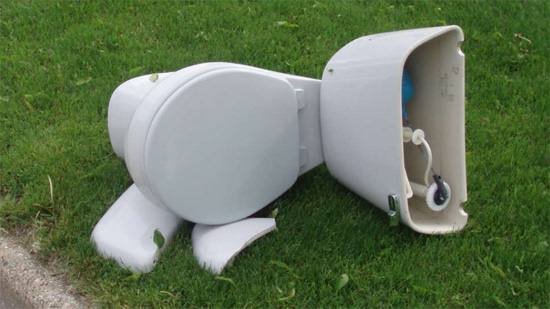Yes, that’s right. I hate my new toilet. Well, maybe hate is too strong of a term. OK, I really dislike my new toilet. Why, you ask? It all boils down to preference. Preference on….what?
While all toilets basically do the same thing [flush, refill, flush…not talking about the composting toilets out there] and there are too many styles and brands of toilets to count, there are two inescapable genres of toilets you and I have to choose from. No, not white or some other color but seriously, white is probably the way to go. I’m talking the choice in height: short versus tall, or more commonly “normal” versus “comfort height”. First, we need to know what those two terms really refer to.
Back before the Americans with Disabilities Act (the ADA for short) was signed into law in 1990, I don’t have the slightest idea what toilet height choices were available. I don’t ever recall thinking about it as a child, either. My parents’ house was a 3-bedroom, 2-bath home in the suburbs and those two toilets were what we had. At least in the era of black or almond-colored toilets they were white. Thinking back, their heights were normal to our family and we didn’t have a clue what the height of a toilet really meant.
Now (fast-forward about three decades) the two leading categories of toilet height probably confuse a few of you, and I would guess most people rarely think about the choice. Why do we have two heights these days? In my opinion it largely boils down to addressing requirements that stem back to the ADA Act to make all types of facilities accessible to all persons regardless of mobility issues, gender, or any other issue. The rise of the comfort height toilet (where the seat is around 17 to 19 inches above the floor) came about to make it easier to either stand back up after use or transfer laterally to a mobility aid such as a wheelchair. Conventional wisdom tells us that it is easier to shift laterally when transferring off a toilet just like when using a regular chair, rather than the uphill direction that used to be required by normal height toilets (seats below 17 inches off the floor).
Furthermore, with the aid of wall-mounted grab bars, if you’re a few inches closer to your standing position, it seems within reason to understand that comfort height toilets make standing easier on those who otherwise struggle to stand up. In the commercial building world, most toilets have been wall-mounted on a carrier in the wall, and you could locate the carrier at the right height so accessible toilets are automatically at the correct (and legally-required) height. In the residential market, manufacturers started making two heights of toilets not necessarily out of legal requirements but out of the realization that the population who prefer higher toilets at the workplace could also be served with comfort height toilets in their homes.

Residential toilets do not often utilize an in-wall carrier so the toilet base has to be manufactured to the desired height because once you have it, you’re stuck with it. The one residential exception I am aware of is the growing category of wall-hung residential toilets which derive their origins from commercial systems and have an in-wall carrier that can be mounted at whatever height you choose. I’ve specified a number of these units with quite modern seats. Unless you’re 7 feet – 2 inches tall, I wouldn’t recommend installing them 20 inches above the floor! Well, probably not then either. You’re probably not the only one using the toilet.
OK, history lesson over and back to my “situation”. Last week I had to replace one of the toilets in my home(*). When I’m working on a design project for a client, the clients needs and tastes will probably lead me to recommend a toilet height for them so we can choose and specify what is needed only once. At my own home, bought in 2007 but built back in 1985, I’m the decision maker on these little things. So I hopped into my truck and went to the local home improvement store and they still carry the same model of toilet that I installed in my home back in ’08 (albeit probably redesigned a bit for lower-flow restrictions now in effect). Bought it, carted it home, and in less time than you think I had replaced the broken toilet with the new one.

Stand back and admire handiwork. Clean up tools and recycle the mess from new toilet’s packing materials.
Only later that evening did I determine that I hate the new toilet. Why? It’s a comfort height unit and my preference is the lower, normal height units. In the words of a certain cartoon character, “Doh!” Either the store carries that model of throne only in comfort height now, or I completely missed the labeling on the package. Either way, I’m not replacing it again – it’s a completely new, working toilet! No adjustment needed!
Well, on the bright side the next time I pull a muscle in my back I can gingerly shuffle over to the disliked comfort height toilet and know that it will be a bit easier to stand up again. So don’t be taken aback if some day in the future when I’m designing a home for you, I ask you normal, or comfort height!
(*) Footnote: the base of the old toilet appeared to have a manufacturing defect causing it to fail over time. It wasn’t my fault! And know that no toilets have been cast off as environmental pollution. I’ve properly disposed of the base and am saving the tank as a back-up since it will fit either of our home’s toilets.
____________________________
This post was originally written before re-branding as Eckxstudio for Modern Architecture at the end of 2017.
At Eckxstudio for Modern Architecture, we design unique and stunning projects, individually crafted for our clients’ lives. We’re passionate about listening to your needs, wants and desires as inspiration to design the dream home you’ll never want to leave.






Leave A Comment